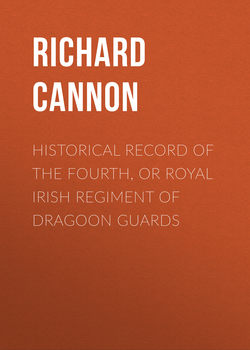Historical Record of the Fourth, or Royal Irish Regiment of Dragoon Guards

Реклама. ООО «ЛитРес», ИНН: 7719571260.
Оглавление
Cannon Richard. Historical Record of the Fourth, or Royal Irish Regiment of Dragoon Guards
PREFACE
INTRODUCTION
HISTORICAL RECORD OF THE FOURTH, OR ROYAL IRISH REGIMENT OF DRAGOON GUARDS
SUCCESSION OF COLONELS OF THE FOURTH, OR ROYAL IRISH REGIMENT OF DRAGOON GUARDS
Отрывок из книги
The ancient Armies of England were composed of Horse and Foot; but the feudal troops established by William the Conqueror in 1086, consisted almost entirely of Horse. Under the feudal system, every holder of land amounting to what was termed a "knight's fee," was required to provide a charger, a coat of mail, a helmet, a shield, and a lance, and to serve the Crown a period of forty days in each year at his own expense; and the great landholders had to provide armed men in proportion to the extent of their estates; consequently the ranks of the feudal Cavalry were completed with men of property, and the vassals and tenants of the great barons, who led their dependents to the field in person.
In the succeeding reigns the Cavalry of the Army was composed of Knights (or men at arms) and Hobiliers (or horsemen of inferior degree); and the Infantry of spear and battle-axe men, cross-bowmen, and archers. The Knights wore armour on every part of the body, and their weapons were a lance, a sword, and a small dagger. The Hobiliers were accoutred and armed for the light and less important services of war, and were not considered qualified for a charge in line. Mounted Archers1 were also introduced, and the English nation eventually became pre-eminent in the use of the bow.
.....
During the summer three troops of the Sixth Horse were encamped on Hounslow Heath. King William had reasons to suspect that several old corps were not well affected towards his interests; but His Majesty appears to have placed entire confidence in the attachment of the officers and men of this regiment to his person and government; and in August a strong detachment left the camp at Hounslow, to take part in the duties of the Court and metropolis. The remainder of the three troops of the Sixth Horse, encamped on the heath, proceeded into quarters at Croydon and Mitcham; and in December, the three troops in the Isle of Wight were removed to Salisbury.
The detachment having been relieved from the King's duty in London, the regiment was removed in February, 1690, into quarters at Oxford and Abingdon. In the following month it received orders to embark for Ireland, to serve under King William, against the French and the Irish Roman Catholics under King James. This order was, however, countermanded, and when the King proceeded with three troops of Life Guards to Ireland, this regiment marched into quarters in the villages near London, in order to take part in the duties of the Court. Having been relieved from this duty by the Fourth Horse (now 3rd Dragoon Guards), the regiment marched into quarters at Portsmouth and Isle of Wight, and subsequently to Salisbury and Winchester.
.....